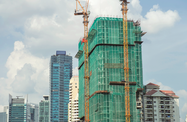With a young population and a growing economy, demand for residential property in the greater Kuala Lumpur (KL) area is expected to remain strong, as new transportation schemes to add to the city’s attractiveness.
Some 65% of the country’s population are now under the age of 35, with many soon to be in the market for their own homes. At the same time, this near-future demand for housing close to jobs and entertainment in KL is being supported by government plans to construct and extend railway lines in the greater KL area. Improved transit points are expected to open up outlying areas of the city, creating a wide tract of commuter towns within range of the capital.
This scenario is laid out in the 10th Malaysia Plan and the Economic Transformation Programme’s Greater KL Plan, identified as one of 12 National Key Economic Areas (NKEAs) by Prime Minister Najib Razak last year.
Indeed, the government’s performance management and delivery unit, Pemandu, has targeted a population of 10m for greater KL by 2020, growth that will create demand for an estimated 1m new homes.
Better transport links will thus be needed. Construction on the Klang Valley Mass Rail Transit (MRT), also known as the Sungai Buloh-Kajang route, is expected to start in July, with a completion target set for 2016.
The route will run from north-west of KL to the south-west, bringing much of the city’s hinterland into play as viable commuter territory. Some 1.2m passengers are expected to use the line, which will also link up with the existing KTM Komuter and Light Rail Transit (LRT) networks.
The MRT link is estimated to be worth RM53bn ($17.6bn) in total, when rolling stock, trains and other systems are included. In addition, a 17-km extension of the existing LRT system is at the advanced planning stage.
Developers expect real estate prices along the MRT line to grow significantly once it is completed. Maximising this potential also means increasing the proximity of communities to the stations. Indeed, Pemandu anticipates the gross development value of the 111,500 sq metres of commercial and residential space in KL’s environs to rise substantially when the MRT link is introduced.
Jamaludin Osman, the group managing director of property developers I & P Group, told OBG that infrastructure development is very far-reaching under the 12 NKEAs, and that through projects like the MRT and LRT, a large part of the economy will see an impact.
“Accessibility to certain areas will, in itself, impact growth and outlook for several areas within the Klang Valley and will thus impact the construction and real estate sector,” said Jamaludin. “Ultimately, property prices will increase and that will impact everyone.”
In an April 9 forum on real estate investment, hosted by financial newspaper the Edge, developers and researchers generally agreed that house prices in Malaysia, especially in the Klang Valley, have been surging in the past year or so and will continue to be buoyed by strong demand from a young population.
At the forum, Ho Chin Soon of Ho Chin Soon Research, which specialises in property information, said there is strong growth potential in areas immediately surrounding the interchanges between the planned MRT stations, especially in the southern portion of KL’s Golden Triangle, such as Bukit Bintang and surrounding areas.
Ho also cited figures that point to a 25-50% increase in capital values and rents for properties within walking distance of, adjacent to or integrated with an MRT station. Opportunities for investment therefore continue to look positive, as the KL area has seen healthy growth in the past decade.
“The average price of two- and three-storey terraced houses in KL has appreciated from RM250,000 ($83,000) in 2000 to around RM550,000 ($182,000) now,” Chris Boyd, the executive chairman of CB Richard Ellis Malaysia, said during the forum, adding that the average price of a two-storey terraced house in the Klang Valley would exceed RM1m ($332,000) within the next 10 years.
This steep rise is due in large part to an undersupply of homes in the Klang Valley area. Citing data from the Valuation and Property Services Department, Boyd said the supply of homes in the Klang Valley was 112,458 in 2003 but had shrunk to 30,037 in 2010. New starts were 76,449 in 2003, dropping to 9328 in 2010.
This gap in supply is a portent of a surge in demand for homes as well as price hikes, as about 20% of the Malaysian population will join the workforce in the coming decades and will be looking for homes close to their jobs.
“Young people coming into the workforce still want to have a pad in the city rather than far away with their parents. This points to demand for small units closer to the city and near the MRT stations,” Boyd said.
With demographics and supply numbers like this on the cards, investment in property in the Greater KL radius is likely to yield strong returns in both the medium and long term.

